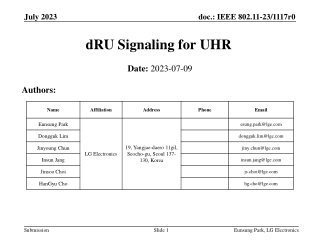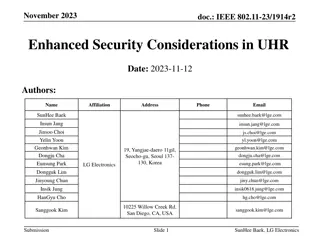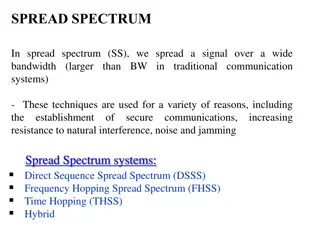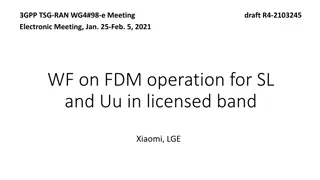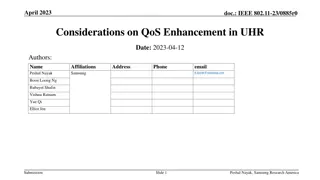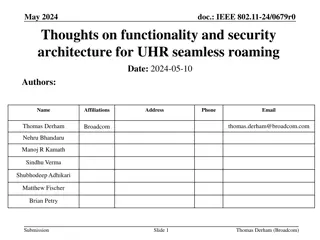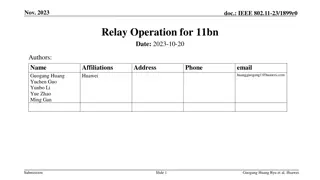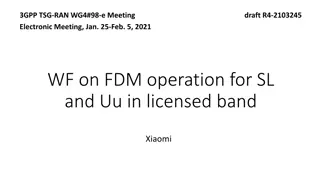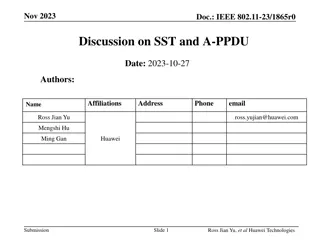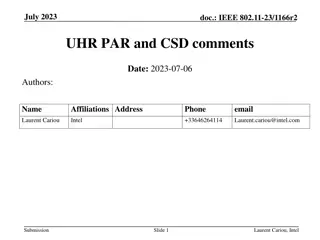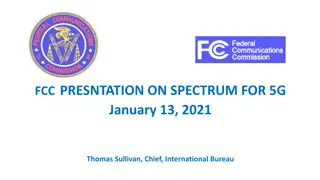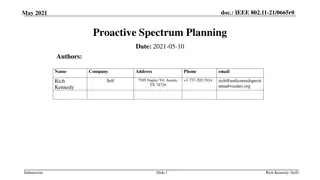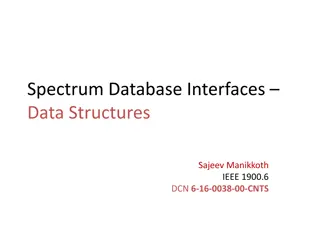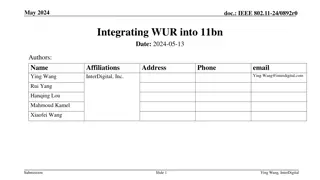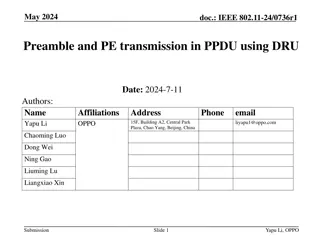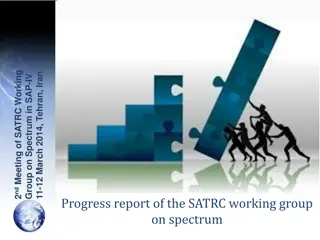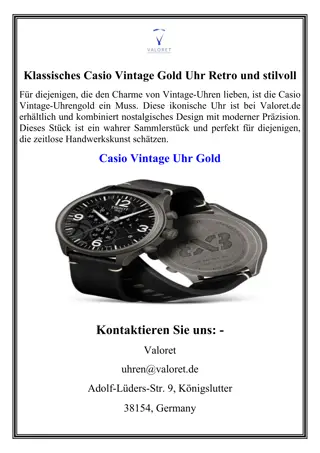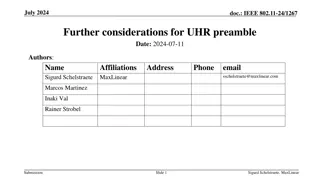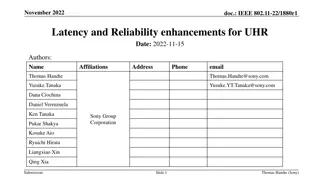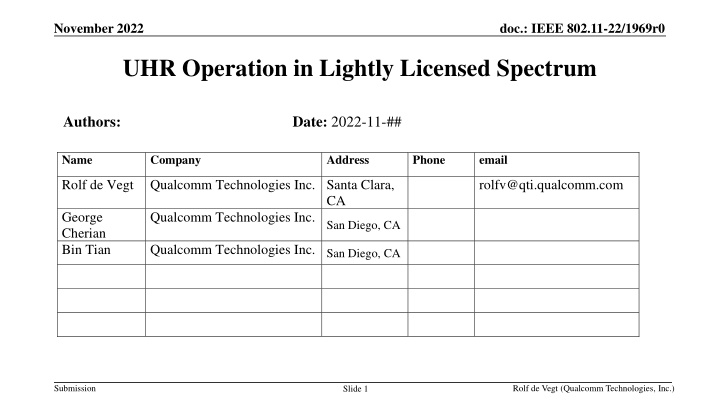
IEEE 802.11-22/1969r0 UHR Operation in Lightly Licensed Spectrum Overview
Explore the potential benefits, design principles, and key considerations of IEEE 802.11-22/1969r0 for operation in lightly licensed spectrum. Learn about the integration into existing infrastructures, regulatory aspects, and the viability of utilizing this spectrum for 802.11 technologies.
Download Presentation

Please find below an Image/Link to download the presentation.
The content on the website is provided AS IS for your information and personal use only. It may not be sold, licensed, or shared on other websites without obtaining consent from the author. If you encounter any issues during the download, it is possible that the publisher has removed the file from their server.
You are allowed to download the files provided on this website for personal or commercial use, subject to the condition that they are used lawfully. All files are the property of their respective owners.
The content on the website is provided AS IS for your information and personal use only. It may not be sold, licensed, or shared on other websites without obtaining consent from the author.
E N D
Presentation Transcript
November 2022 doc.: IEEE 802.11-22/1969r0 UHR Operation in Lightly Licensed Spectrum Authors: Date: 2022-11-## Name Company Address Phone email Rolf de Vegt Qualcomm Technologies Inc. Santa Clara, rolfv@qti.qualcomm.com CA George Cherian Bin Tian Qualcomm Technologies Inc. San Diego, CA Qualcomm Technologies Inc. San Diego, CA Submission Rolf de Vegt (Qualcomm Technologies, Inc.) Slide 1
November 2022 doc.: IEEE 802.11-22/1969r0 Topics Introduction Potential Benefits Considerations Preliminary Design Principles Implications for UHR effort Submission Slide 2 Rolf de Vegt (Qualcomm Technologies, Inc.)
November 2022 doc.: IEEE 802.11-22/1969r0 Introduction In multiple geographies, governments are considering making spectrum available for Lightly Licensed Operation e.g. for Private Networking Some preliminary examples: Germany: 3700 - 3800 MHz for industrial applications Europe: 3800 - 4200 MHz per a new draft mandate US: 3550 3700 MHz for CBRS Japan: 4.6 4.9 GHz (targeting 5G PN) Often the originally pursued use is by 5G cellular technologies, however adoptions is relatively slow and regulations are typically technology neutral *; i.e. 802.11 technologies could be deployed, assuming regulatory parameters are met * e.g. the draft EU mandate on 3.8 4.2 for terrestrial wireless broadband systems calls for: support the principles of service and technological neutrality, non-discrimination and proportionality insofar as technically possible . Submission Slide 3 Rolf de Vegt (Qualcomm Technologies, Inc.)
November 2022 doc.: IEEE 802.11-22/1969r0 Potential benefits of 802.11 technologies for lightly licensed spectrum Ease of integration into existing WLAN network infrastructure Existing back-end infrastructures Networking expertise present Ease of integration into existing multi-radio AP designs, where appropriate for use case (e.g. robotics manufacturing environment) No rogue Wi-Fi devices impacting network performance No foreign OBSS s Benefits resulting from the ability to run fully scheduled and infrastructure controlled modes Potential ability to leverage 6GHz AFC system infrastructure for licensing management May provide a pathway for regulators to gradually make spectrum available to unlicensed operation in a more controlled manner Submission Slide 4 Rolf de Vegt (Qualcomm Technologies, Inc.)
November 2022 doc.: IEEE 802.11-22/1969r0 Key Considerations on Viability for 802.11 For this opportunity to be viable there are a number of factors to consider: Minimum amount of spectrum availability 100 MHz minimum? Frequency band alignment amongst geographies making lightly licensed spectrum available Need for ability to cover multiple geographies with a single RF Receiver design OOB emissions requirements, channel spectrum masks and output power limits that are economically feasible for 802.11 technology Submission Slide 5 Rolf de Vegt (Qualcomm Technologies, Inc.)
January 2022 doc.: IEEE 802.11-22/1969r0 Applications Considerations Current Lightly licensed regimes currently typically target licensing to enterprises, research institutes and government entities for specific geographic locations Some potential usages enabled: Deterministic and ultra low latency applications with relatively low payload/throughput requirements such as robotics and manufacturing control Support for large numbers of low power IOT devices, e.g. ESL in retail Effective load balancing and seamless hand off between AP s enabled by strict infrastructure control Open to further security enhancements Submission Slide 6 Rolf de Vegt (Qualcomm Technologies, Inc.)
November 2022 doc.: IEEE 802.11-22/1969r0 Why part of UHR The timing is right now that Regulators worldwide are making spectrum available for Lightly Licensed operation typically on a Technology Neutral basis Embracing Greenfield Lightly Licensed spectrum has a strong potential to achieve further benefits regarding the following four UHR targets: Improve reliability of WLAN connectivity Predictable latency Increase manageability Reduce device level power consumption Including lightly licensed spectrum operation increases the potential for 802.11 UHR to match or exceed competitive benchmark KPI s Submission Slide 7 Rolf de Vegt (Qualcomm Technologies, Inc.)
November 2022 doc.: IEEE 802.11-22/1969r0 Design Principles - Preliminary Reuse baseline Wi-Fi as much as possible Operate in fully scheduled trigger-based mode using baseline scheduling techniques with added rules (say, MU EDCA=0) Allows predictable latency Minimize the management frames in this band, by taking advantage of 11be MLO operation Conduct discovery, authentication, and other management procedures on other bands Helps to fully utilize the spectrum for delivering the payload Also include the definition of a fully stand-alone mode E.g. for vendors or network owners who prefer to only operate on the lightly licensed frequencies Should be able to use baseline QoS framework, with some extensions Example, QoS for IIoT requirements Other changes TBD For example, PHY changes TBD Submission Slide 8 Rolf de Vegt (Qualcomm Technologies, Inc.)
November 2022 doc.: IEEE 802.11-22/1969r0 Implications for the UHR efforts Leave open the possibility in the PAR to cover lightly licensed spectrum frequencies PAR not to exclude fully scheduled MAC mode and consider technology for inclusion in UHR standard Submission Slide 9 Rolf de Vegt (Qualcomm Technologies, Inc.)

